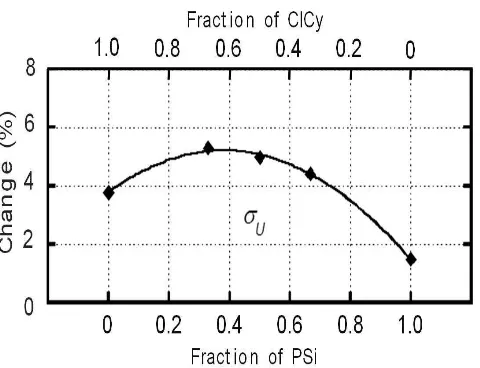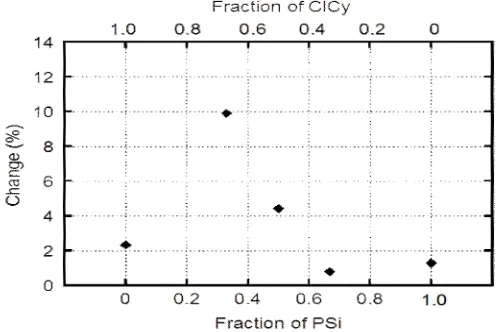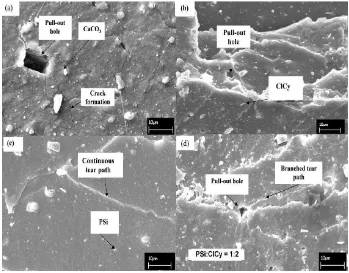EFFECTS OF FILLER HYBRIDIZATION ON THE MECHANICAL PROPERTIES OF NR/SBR/EPDM RUBBER BLENDS
T.C., Soh1, N., Mohamad2,Q., Ahsan3, M.E. and Abd Manaf4
1,2,3,4 Department of Engineering Materials,
Faculty of Manufacturing Engineering,
Universiti Teknikal Malaysia Melaka, Hang Tuah Jaya, 76100 Durian Tunggal, Melaka, Malaysia.
Email: *1[email protected]; 2[email protected]; 3[email protected];4[email protected]
;
ABSTRACT
: Hybridization of active fillers is one of the techniquesutilized to enhance rubber properties. This study highlights the effects of filler hybridization on the mechanical properties of an industrial applied natural rubber/styrene butadiene rubber/ethylene propylene diene terpolymer (NR/SBR/EPDM) Rubber Mat compound reinforced by non-black fillers. Initially, three different rubber compounds were prepared; i) calcium carbonate (CaCO3)-filled NR [CaCO3NR] as reference sample, ii) precipitated
silica (PSi)-filled NR/SBR/EPDM [PSiBR], and iii) calcined clay (ClCy)-filled NR/SBR/EPDM [ClCyBR]. From these compounds, composites of NR/SBR/EPDM were prepared. The ratio of PSi:ClCy was varied to study the effects of filler hybridization. CaCO3 was added for cost advantage
industrially and its level was fixed. It was found that inclusions of ClCy and PSi individually and their hybridizations show higher tensile and tear strengths than the reference sample. Particularly, the largest improvement was found with the amount of ClCy which is higher than PSi. A ratio of PSi:ClCy in this particular range (1:2 to 2:3), seems to provide the optimum packing factor for good interaction between the fillers. SEM analysis suggests that better dispersion and packing of fillers due to size and shape of hybrid fillers play an important role in improving the composite properties.
KEYWORDS
: Natural Rubber, Styrene Butadiene Rubber, Ethylene PropyleneDiene Terpolymer, Hybrid Filled System, Non-black Filler
1.0 IN T R O D U C T I O N
the strain energy to prevent any possible flaw from spreading [2,5]. Petroleum synthesized carbon black is associated with pollution issues and only suits dark color rubber products [6,7]. Thus, non-black fillers with principally clay, precipitated silica and calcium carbonate are industrially preferable today [8]. Rattanasom et al. [9] claimed that a carbon black-reinforced rubber exhibits higher modulus than a silica-reinforced one but the latter provides a unique combination of tear strength, aging resistance and adhesion properties. Although application of precipitated silica is gaining prominence nowadays, the poor rubber-filler interaction due to the highly polarity of silica impairs the rubber mechanical properties. Generally, organosilane is used to improve the rubber-filler interaction [10,11]. Clays are hydrated aluminium silicates with hexagonal shaped platelet layers [12]. The strong ionic interactions between polymer and silicate layers that generate crystallinity at the interfaces are responsible for reinforcement [13]. The clay layers introduce an extra energy dissipation mechanism contributed by enhanced crystallization under the strains [14].
Hybrid multiphase filler system retains the advantages of all fillers and provides synergistic effect of rubber reinforcement [15]. Rohini Thimmaiah and Siddaramaiah [16] reported that the adding of metakaolin into carbon black-added natural rubber compound at as low as 5 phr can confer optimized tensile properties. Moreover, Liu et al. [14] revealed that clay platelets can construct a hybrid network through physical contact with carbon black that could act as micro-barrier to increase the crack path of rubber vulcanizates.
This study examines the mechanical properties of natural
rubber/styrene butadiene rubber/ethylene propylene diene
terpolymer (NR/SBR/EPDM) blends filled with different ratios of hybrid non-black fillers i.e. calcium carbonate (CaCO3), precipitated
2.0 METHODOLOGY
NR (L-grade) was supplied by Hockson Rubber Trading, EPDM (Nordel P4520) at 50 % ethylene and 5 % diene was supplied by Dow Chemical Company. SBR (Intol 1502) with MV of 52 was supplied by Polimeri Europa UK Ltd. PSi with surface area of 161-190 m2/g was
supplied by Euro Chemo Sdn. Bhd. ClCy with surface area of 12-16
m2/g was supplied by Tangshan Madison Kaolin Co. Ltd., while
Organosilane, 3-triethoxysilylpropyltetrasulphide (TESPT) was
supplied by Innova Chemical Co. Ltd. Other ingredients include
CaCO3, ZnO white, stearic acid, mercaptobenzothiazole disulphide
(MBTS), diphenyl guanidine (DPG), polyethlene glycol, phenolic antioxidant, homogenizing resin, Zn soap, parafinic oil and sulfur were the grades customarily used in rubber industries. Compounding was performed by using a laboratory two-roll mill according to ASTM D3182. The First stage mixing involved preparations of three initial
compounds; (i) CaCO3-filled NR (CaCO3NR), ii) PSi-filled blend
rubber (PSiBR), and (iii) ClCy-filled blend rubber (ClCyBR). The
blend rubber consists of NR, SBR and EPDM. CaCO3NR was referred
to an industrial Rubber Mat formulation which was used as a reference sample in the present study. For PSiBR and ClCyBR, prolonged mixing were performed at temperature of 70-80 °C for 120 min at 1 mm of roller nip in order to improve the dispersion and distribution of fillers and to attain complete silanization of TESPT. The formulations of the compounds in part per hundred rubber (phr) are listed in Table 1.
Table 1: Formulation of the initial compounds
The Second stage involved mixing of 5 compounds in different combinations of PSiBR and ClCyBR with fixed percentage of
CaCO3NR as depicted in Table 2. These combinations represent the
ratios of rubbers and fillers as shown in Table 3.
Table 2: Different combinations of the initial compounds
Sample No. CaCO3NR (%) PSiBR (%) ClCyBR (%)
Table 3: Compositions of hybrid-filled rubber composites
Sample No. NR (phr) SBR (phr) EPDM (phr) CaCO3 (phr) PSi (phr) ClCy (phr) vulcanizates were prepared by using compression molding at 165 °C
and pressure of 150 kg/cm2. Tensile and trouser tear test were
Figure 1: Relation between changes of σu in PSi/ClCy/CaCO3-filled
composites as the function of PSi/ClCy ratios
Additions of PSi and ClCy fillers enhance σu of vulcanizates. As
shown in Figure 1, the changes of σu follow a positive quadratic
model of polynomial second order, with the coefficient of
determination value of R2 = 0.998. This means that hybrid-filled
composites yields higher values than those added with only PSi or ClCy. The result can be attributed to the synergistic reinforcing effects of the simultaneous presence of PSi and ClCy. From the curve, the largest improvement is achieved when the ratio of PSi:ClCy is about 2:3. This may render to efficient physical interlocking between hybrid fillers and matrix when the amount of PSi was lesser than ClCy. It is in good agreement with a study conducted by Freeman et al. [17] which found that clay is useful to partially replace silica while maintaining acceptable physical properties of rubber composites. The
smaller improvement of σu shown by the composite added with only
PSi compared to that added with only ClCy may be due to the insufficient silanization of bulky silanol groups of PSi with rubber
matrix ascribed to lower mixing temperature of 70-80 0C that caused
failure in rubber-filler linkages formation. It has been reported that at
least 130 0C mixing temperature is necessary to ensure desired
silanization reactions in rubber matrix [18]. Thus, the increase of
rubber σu as observed in this study is thought to be predominantly
to improve the rubber tear strength compared to the CaCO3NR
reference sample as shown by the positive changes in Figure 2.
Figure 2: The changes in the tear strength of PSi/ClCy/CaCO3-filled
composites as the function of PSi/ClCy ratios.
Similar to the result observed for σu, the composite added with higher
amount of ClCy and lesser PSi shows the largest improvement in tear strength. This is due to the efficient interlocking between hybrid fillers and matrix that acts as physical barrier perpendicular to the tear direction which subsequently delays the crack growth. The ratio of 1:2 between PSi and ClCy hybridization seems to provide the optimum packing factor for good fillers interaction. The clay layers may construct a dual phase filler network with precipitated silica aggregates to enhance the tear resistance as reported by Liu et al. in the case of clay/carbon black hybridization [14]. The filler networks divert effectively the tear propagation path through a more tortuous path which consumes more energy for propagation.
Figure 3: SEM secondary electron micrograph on the fractured surfaces at magnification of 1000 x for (a) CaCO3NR, (b) ClCy/CaCO3-filled composite
(Sample 1), (c) PSi/CaCO3-filled composite (Sample 5) and
(d) PSi/ClCy/CaCO3-filled composite (Sample 2).
Figure 3(a) shows the ruptured surface of pure CaCO3NR reference
sample that is observed to have large CaCO3 particles distributed
throughout the smooth surface of rubber matrix. They are
approximately having the size of raw CaCO3 (~8 µm), while some are
agglomerated into larger sizes (~10 µm) as shown by the pull-out
hole. The presence of large particles CaCO3 can weaken the rubber by
creating structural flaws to deteriorate the tear strength. Furthermore, profuse microvoids are found on the fractured surface indicating poor rubber-filler interaction renders to debonding of fillers from the rubber matrix. Moreover, numerous secondary cracks perpendicular to the principle surface of the reference sample are also observed. The formation of grooves and deep cracks are correlated with inefficient energy transfer mechanism between matrix and reinforcing fillers [19].
In comparison to the smooth fractured surface of CaCO3NR, the
rougher web-step profile as shown in Figure 3(b). Rougher failure surface indicates that the fillers in the rubber matrix have effectively enhancedthe reinforcement in the rubber vulcanizates to allow better stress transfer and improve the mechanical properties [20]. The fractured surface shows limited debonding between the fillers and the rubber matrix and fewer microvoids compared to that of the reference sample. Furthermore, it is observed that ClCy particles (~3 µm) are distributed evenly in the rubber matrix with no excessive agglomeration indicating good filler dispersion. The fracture surface
of PSi/CaCO3-filled composite is shown in Figure 3(c). There are
continuous tear paths observed on the fractured surface from one end to another with lesser surface roughness compared to the ClCy-loaded vulcanizate. The presence of unrestricted tear paths from one end to the other of the fractured surface indicates poor tear strength [20]. This explains why the tear strength of the composite added with only PSi is inferior to that added with only ClCy as discussed above. However, it is observed that PSi aggregates with diameter around 0.5-1 µm are well-distributed evenly in the rubber matrix which imparts
better tear strength than the reference sample of CaCO3NR. The small
aggregate of PSi is beneficial to enhance the rubber mechanical properties due to increased rubber-filler interfacial but on the contrary, large agglomerates act as stress concentrators to decrease the properties of products [21,22]. The fractured surface of hybrid
PSi/ClCy/CaCO3 composite added with PSi/ClCy at ratio 1:2 which
shows high values of tensile and tear strengths is shown in Figure 3(d). The surface exhibits aggregates of PSi and ClCy are inter-dispersed and distributed across the rubber matrix. A rough fractured surface with short branching of tear paths is observed. The rough fractured surface, i.e. the so called cross-hatched pattern, composed of numerous webs and steps in different sizes is an indication of blunt tear, while a smooth indicates a sharp tear [14]. Thus, it is reasonable to postulate that the achievement of tear strength enhancement relates to the formation of subsidiary cracks induced by the hybridization of PSi and ClCy.
4.0 C O N C L U S I O N S
hybridization. It can be said that a ratio of PSi:ClCy in this particular play an important role in improving the rubber properties.
A C K N O W L E D G E M E N T S
The authors would like to acknowledge the Ministry of Education Malaysia, Universiti Teknikal Malaysia Melaka and Rubber Leisure Products Sdn. Bhd. for their kind contributions on financial support, research materials and test facilities in carrying out this study.
R E F E R E N C E S
[1] J. Wang, Y. Chen and J. Wang, “Novel reinforcing filler: Application to natural rubber (NR) system”. Journal of Elastomers and Plastics, Vol. 37, No.2, pp. 169-180, 2005.
[2] B. Rodgers, Rubber Compounding: Chemistry and Applications. New York: Marcel Dekkal, 2004.
[3] A. Ansarifar, R. Nijhawan, T. Nanapoolsin and M. Song, “Reinforcing effect of silica and silane fillers on the properties of some natural rubber vulcanizates”. Rubber Chem. and Tech, Vol. 71, No.5, pp. 1290-1309, 2003.
[4] Indian Rubber Institute, Rubber Engineering. New Delhi: Tata McGraw-Hill, 1998.
[5] B. Kothandaraman, Rubber Materials. New Delhi: Ane Books Pvt. Ltd, 2008.
[6] H. Ismail and M. Mathialagan, “Comparative study on the effect of partial replacement of silica or calcium carbonate by bentonite on the properties of EPDM composites”. Polymer Testing, Vol. 31, pp. 199-208, 2012.
[8] J.R. White and S.K. De, Rubber Technologist’s Handbook. Shawbury, Shrewsbury, Shropshire: Rapra Technology Limited, 2001.
[9] N. Rattanasom, S. Prasertsri and T. Ruangritnumchai, “Comparison of the mechanical properties at similar hardness level of natural rubber filled with various reinforcing-fillers”. Polymer Testing, Vol. 28, pp. 8-12, 2009.
[10] Y.K. Jae, K, Prakashan and K.K. Jin, “New silane coupling agents for silica tire tread compounds”. Journal of Elastomers and Plastics,Vol.44(6), pp. 549-562, 2012.
[11] S. Pongdhorn, T. Uthai and H. Kannika. “Effect of curing system on reinforcing efficiency of silane coupling agent”. Polymer Testing, Vol. 23, pp. 397-403, 2004.
[12] R.B. Simpson, RubberBbasics. Shawbury, Shrewsbury, Shropshire: Rapra Technology Limited, 2002.
[13] L.E. Yahaya, K.O. Adebowale, A.R.R. Menon, S. Rugmini, B.I. Olu-Owolabi and J. Chameswary, “Natural rubber/clay nanocomposites: Effect of filler dosage on the physicomechanical properties of vulcanizates”. African
Journal of Pure and Applied Chemistry, Vol. 4, No.9, pp. 198-205, 2009.
[14] Y. Liu, L. Li, Q. Wang and X. Zhang, “Fracture properties of natural rubber filled with hybrid carbon black/nanoclay”. J Polym Res, Vol. 18, pp. 859-866, 2011.
[15] Y.B. Liu, L. Li and Q. Wang, “Reinforcement of natural rubber with carbon black/nanoclay hybrid filler“. Plactic, Rubber and Composites,Vol. 39, No.8, pp. 370-376, 2010.
[16] S. Rohini Thimmaiah and Siddaramaiah, “Investigation of carbon black and metakaolin cofillers content on mechanical and thermal behaviours of natural rubber compounds”. Journal of Elastomers and Plastics, Vol. 45, No.2, pp. 187-198, 2012.
[17] M.G. Freeman, C.J. Marshall, W.O. Lackey, M. Onizawa and J.M. Huber Corporation, Silane-Treated Clay Production Method, Silane-Treated Clay and
Composition Containing Same. Patent 6,013,699, Japan, 2000.
[18] L.A.E.M. Reuvekamp, J.W. ten Brinke, P.J. VAN Swaaij and J.W.M. Noordermeer, “Effects of time and temperature on the reaction of TESPT silane coupling agent during mixing with silica filler and the rubber”. Rubber
[19] K.N. Pandey, D.K. Setua and G.N. Mathur, “Material behaviour: Fracture topography of rubber surfaces”. Polymer Testing, Vol. 22, pp. 353-359, 2003.
[20] S.S. Idrus, H. Ismail and S. Palaniandy, “Study of the effect of different shapes of ultrafine silica as fillers in natural rubber compounds”. Polymer
Testing, Vol. 30, pp. 251-259, 2011.
[21] I.M. Zloczower, Mixing and Compounding of Polymers, 2nd Edition. Ohio: Hanser Gardner Publications, Inc, 2009.
[22] N. Mohamad, A. Muchtar, M.J. Ghazali, H.M. Dahlan and C.H. Azhari, “Investigation on Impact Fracture of Epoxidized Natural Rubber-Alumina Nanoparticle Composites (ENRAN)”. Global Engineers and Technologists


